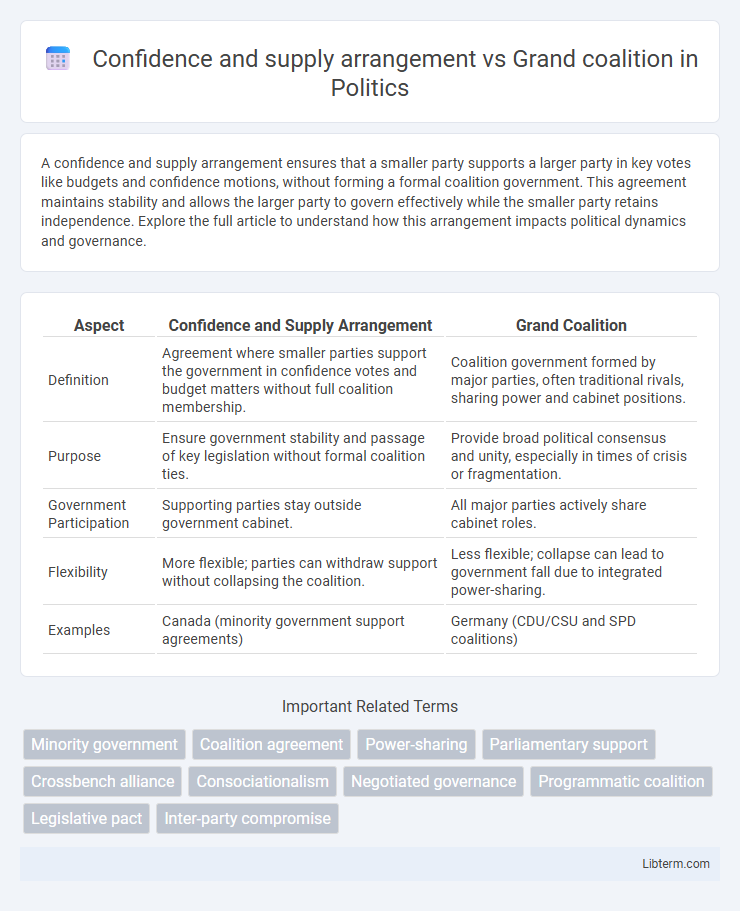A confidence and supply arrangement ensures that a smaller party supports a larger party in key votes like budgets and confidence motions, without forming a formal coalition government. This agreement maintains stability and allows the larger party to govern effectively while the smaller party retains independence. Explore the full article to understand how this arrangement impacts political dynamics and governance.
Table of Comparison
| Aspect | Confidence and Supply Arrangement | Grand Coalition |
|---|---|---|
| Definition | Agreement where smaller parties support the government in confidence votes and budget matters without full coalition membership. | Coalition government formed by major parties, often traditional rivals, sharing power and cabinet positions. |
| Purpose | Ensure government stability and passage of key legislation without formal coalition ties. | Provide broad political consensus and unity, especially in times of crisis or fragmentation. |
| Government Participation | Supporting parties stay outside government cabinet. | All major parties actively share cabinet roles. |
| Flexibility | More flexible; parties can withdraw support without collapsing the coalition. | Less flexible; collapse can lead to government fall due to integrated power-sharing. |
| Examples | Canada (minority government support agreements) | Germany (CDU/CSU and SPD coalitions) |
Understanding Confidence and Supply Arrangements
Confidence and supply arrangements are agreements where smaller parties support a minority government in key votes like budgets and confidence motions, ensuring stability without full coalition membership. This arrangement provides flexibility, allowing parties to maintain distinct identities while enabling the government to pass legislation. Unlike a grand coalition, where major parties formally share executive power, confidence and supply agreements focus on selective legislative support rather than joint governance.
What Is a Grand Coalition?
A grand coalition is a government formation in parliamentary systems where the largest political parties, often from opposing ideological spectrums, join forces to create a stable majority. Unlike a confidence and supply arrangement where smaller parties support a minority government without formal cabinet participation, a grand coalition involves direct collaboration and shared executive power among major parties. This type of coalition is typically pursued during times of national crisis or political deadlock to ensure effective governance.
Key Differences: Confidence and Supply vs Grand Coalitions
Confidence and supply arrangements involve a minority government receiving support from other parties to pass budgets and confidence motions without forming a formal coalition, preserving some political independence. Grand coalitions entail multiple major parties formally sharing executive power and cabinet positions, often including opponents, to create a broad-based government. Key differences include the level of formal power-sharing, the size and scope of cooperation, and the political stability offered by each framework.
Typical Scenarios for Confidence and Supply
Confidence and supply arrangements typically occur in parliamentary systems where a minority government lacks an outright majority but secures support from smaller parties to pass budgets and confidence motions without forming a full coalition. This scenario is common in hung parliaments, such as the UK after the 2017 general election, where the Conservative Party relied on the Democratic Unionist Party for key votes. Unlike grand coalitions that merge major parties into a single government, confidence and supply agreements maintain distinct party identities while ensuring legislative stability and government survival.
Conditions Favoring Grand Coalitions
Grand coalitions are favored in parliamentary systems facing national crises or when no single party commands a majority, requiring broad-based cooperation to ensure political stability. These arrangements often arise under polarized political landscapes where parties prioritize governance over ideological differences, enabling inclusive decision-making. Confidence and supply agreements, in contrast, tend to involve fewer parties and are employed when minority governments seek specific support without full coalition integration.
Power Distribution and Governance Dynamics
Confidence and supply arrangements involve minority governments supported by other parties on key votes, allowing more flexible power distribution without full cabinet inclusion. Grand coalitions merge major parties into a unified government, leading to broad power sharing and centralized decision-making. Governance dynamics in confidence and supply favor negotiated agreements with external parties, whereas grand coalitions emphasize collective responsibility among coalition partners.
Pros and Cons of Confidence and Supply
Confidence and supply agreements provide a flexible framework allowing minority governments to remain in power without forming a full coalition, ensuring stability by securing support on key votes like budgets and confidence motions. This arrangement enables the supporting party to influence legislation without taking full cabinet responsibility, preserving their distinct identity, but it may lead to policy trade-offs and uncertainty due to reliance on negotiated support. However, confidence and supply can limit government durability compared to a grand coalition, as withdrawal of support can trigger elections or parliamentary deadlock.
Advantages and Drawbacks of Grand Coalitions
Grand coalitions unify major political parties, ensuring broad representation and stable governance during crises, but often lead to diluted policy agendas and reduced opposition scrutiny. This inclusive approach fosters national unity and quick consensus, yet can undermine democratic accountability by blurring party distinctions. Power-sharing in grand coalitions may marginalize smaller parties, limiting political diversity and innovation.
Case Studies: Historical Examples and Outcomes
The confidence and supply arrangement, exemplified by the 2017 UK agreement between the Conservative Party and the Democratic Unionist Party, allowed a minority government to pass budgets and maintain power with negotiated policy concessions. In contrast, grand coalitions like Germany's post-2013 CDU-CSU and SPD partnership combined major parties to achieve stable governance, often at the expense of clear opposition. Case studies reveal that confidence and supply offers flexibility and policy influence to smaller parties, while grand coalitions provide broad consensus but risk voter dissatisfaction due to blurred party distinctions.
Impacts on Political Stability and Policy-Making
Confidence and supply arrangements create political stability by ensuring governing parties maintain legislative support without formal coalition commitments, allowing for more flexible policy-making and fewer compromises. Grand coalitions often enhance stability through power-sharing between major parties but can lead to policy gridlock due to ideological differences and extensive compromise. The choice between these arrangements significantly affects the balance between effective governance and party autonomy in parliamentary systems.
Confidence and supply arrangement Infographic

 libterm.com
libterm.com